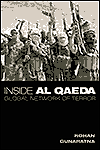|
| Home | About Kashmir Herald | |
Volume 2, No. 10 - March 2003 |
|
| Featured Article |
|
|
|
Rewriting History and Mahmud Ghaznavi Vinod Kumar Ever since the Bharatiya Janata Party (BJP) headed coalition came to power in Delhi, "rewriting of history" has been a contentious issue. For over four decades, Marxist historians have dominated writing of history books. They now assert the BJP is rewriting history. They accuse the BJP (and the Sangh parivar) of transforming "popular understandings of Indian history by changing the content and manner of history teaching at the level of schools and colleges so as to accord with its own Hindutva version of that history". Before I go any further, let me make it clear that neither am I a member of BJP nor I am taking a pro-BJP stand while I write this article. I simply state the historical facts objectively. What is history? As per Webster's New Twentieth Century dictionary, HISTORY is defined as (a) an account of what has happened in the life or development of a people, country, institution in detail (b) all recorded events of the past. The eminent Indian historian Dr. R.C. Majumdar wrote that history should express the truth, without fear, envy, malice, passion or prejudice and irrespective of all extraneous considerations. This comment precisely sums up what is expected of a historian when he writes down a narration or a report or a book. He further emphasizes that the "sole aim" of the history "is to find out the truth by following the canons commonly accepted as sound by all historians". Whether the past history glorifies anyone or is full of ugly incidents, the future generations must be told. There is no shame in telling the truth. In this article, let us focus on how Mahmud Ghaznavi is portrayed in history books written for Indian school children and what his contemporary and other Muslim historians wrote about him. Why Mahmud Ghaznavi to start with? It is because Mahmud Ghaznavi is a pivotal figure in Indian history who invaded India numerous (14 - 17) times, laid the groundwork for future Muslim rule in India, and forever changed the course of its history. He is regarded as a champion of Islam by the Muslims; but he is no hero to Indians. No other Muslim invader invokes as much negative emotions, even bordering on hatred, as Mahmud. Interestingly, he has left much historical evidence for future scholars to research and analyze. From Utbi's (secretary of Mahmud) to Tarikh-I-Badauni, there are at least fourteen authentic histories pertaining to Mahmud's invasions. Each book might vary in its contents regarding names of places, year and the number of invasions, but the big picture that emerges is quite consistent. HISTORY OF INDIA, for grade XI written "strictly according to the Latest Syllabus and style Recently Issued by the central Board of Secondary Education, New Delhi has one and a half pages on Mahmud Ghaznavi. This book states that while "some historians hold that Mahmud wanted to propagate Islam in India, whereas, most of the scholars assert the chief aim of Mahmud was to rob." He robbed India after every war and carried away fabulous wealth to Ghazni. It emphasizes "so it is true that he invaded India to satisfy his lust for money." Unlike our Marxist historians, Utbi, Mahmud's secretary has different take on why Mahmud invaded India. In his Tarikh-e Yamini, he writes Mahmud first wanted to go to Sijistan, but subsequently changed his mind for "a holy war against Hind". Utbi's account details how Sultan Mahmud "purified Hind from idolatry and raised mosques" and how after the victory, Mahmud directed the polluted infidel Jaipal (the King of Shahi dynasty of Peshawar) be paraded about in shame and disgrace so that the fear of Islam might fly about through the country. Minhaju-s Siraj in his Tabakat-I Nasiri calls Mahmud "one of the greatest champions of Islam." He credits Mahmud for "converting as many as a thousand idol-temples into mosques." It is true, as the history book states that Mahmud robbed India after every war. He looted immense wealth from India, probably unparalleled in the history of the world. However, this tells only an incomplete story leaving out many important events to see the big picture. The available evidence makes it clear that Mahmud did more than just rob India of its wealth. After each war there was general massacre of the Hindus and demolition and desecration of Hindus temples and idols. Utbi describing the battle of Thanesar records "the blood of the infidels flowed so copiously that the stream was discolored, notwithstanding its purity, and the people were unable to drink it." This is not an isolated case. This was the general pattern of Mahmud's campaigns in India. About the battle with Chand Rai of Sharwa (Cunnigham places it near present Saharanpur) Utbi records that the Musulmans paid no regard to the booty till they had satiated themselves with the slaughter of the infidels and worshippers of the sun and fire." How great the massacre must have been might be judged from Utbi's statement that it took three days to search the bodies of the dead to collect the booty. "The booty in gold, silver, rubies and pearls amounted to three thousand thousand ( three million - as Al Beruni notes in his Indica, the Muslims' count went only up to thousand) dirhams and the number of prisoners may be conceived from the fact, that each was sold from two to ten dirhams" Utbi goes on to record. Tarikh-e Afifi adds that the fifth share of the Saiyids was 150,000. Also, after the conquest of Nardin Mahmud returned with immense booty and slaves were so "plentiful that they became very cheap; and men of respectability in their native land, were degraded by becoming slaves of common shopkeepers." Historians record that the streets of Ghazni looked like an Indian town. Utbi calls Mahmud "zealous for Muhameddan faith." The truth behind the statement can be judged from two anecdotes: When approached to spare the idol of Thanesar, highly revered by the Hindus, in exchange of substantial "annual tribute and fifty elephants and jewels to a considerable amount", Mahmud simply turned it down saying: "The religion of the faithful inculcates the following tenet: 'That in proportion as the tenets of the Prophet are diffused, and his followers exert themselves in the subversion of idolatry, so shall be their reward in heaven;' that therefore, it behoved him, with the assistance of God, to root out the worship of idols from the face of India. How, then, should he spare Thanesar?" He repeated similar sentiments when, at Somnath, he was offered a huge compensation to spare the idol. Even his nobles pointed to him that "he could not obtain so much treasure by breaking the idol, and the proferred money would be very serviceable." His reply was simple and straightforward. He preferred the glory of his religion above any booty. He said: "I know this, but I desire that on the day of resurrection I should be summoned with the words 'Where is that Mahmud who broke the greatest of heathen idols?' rather than by these: 'Where is that Mahmud who sold the greatest of the idols to the infidels for gold?'" Evidently, Mahmud was not interested in booty alone. He razed the temple to the ground and broke the idol into four pieces. Firishta writes "two pieces of the idol were to be broken off and sent to Ghazni so that one might be thrown at the threshold of the public mosque and the other at the court door of his own palace. These identical fragments are to this day (now 600 year ago) to be seen at Ghizany. Two more fragments were reserved to be sent to Mecca and Medina." The above goes to explain why, Caliph Al Kadir Bi-Ilah honored him with a standard and the title of Kahfu-d daulat wau-l Islam - Guardian of the State and of Islam. Mostly the Hindus confronted Mahmud, fought bravely and many times came close to defeating him. But the massacres following the defeat of the Hindus were so brutal that it created terror in the heart of potential adversaries and thus, in some cases, the Hindus preferred to flee or kill themselves rather subject themselves to cruel and furious massacre, or conversion to Islam. Such a medieval thinking among rulers in Islamic countries continues even today. The strategy of instilling terror into the heart of enemy was elaborated recently by Brig. S. K. Malik of Pakistan Army in his The Quranic Concept of War. He wrote: "Terror struck in the heart of the enemies is not only a means, it is the end in itself. Once a terror into opponent's heart is obtained, hardly anything is left to be achieved." There is more to Mahmud's zeal for raging Hindu temples to the ground but the lack of space prevents us from including other historical evidence. The more one digs into the historical evidence on Mahmud's life, the clearer it becomes that Mahmud invaded India not only " to satisfy his lust for money" but to instill fear among the infidels and to propagate his faith. The Marxist historians have faulted in writing the TEXT BOOKS of history by suppressing the evidence. From reading European or American history, penned by historians from these countries, one will realize that it contains all kinds of unpleasant things of the past. In particular, school children in the United States learn not only about the Red Indians or the native Americans, but also the harm done to their heritage and their physical safety by the European settlers. In the same way the subject of slavery is treated with no apologetics - with all its ugliness and bigotry in full view. Similarly, the holocaust of six million Jews with all its gory details is not suppressed. By the way, it is not up to us to wish upon as how the past history of Mahmud should have been. It is rather the historical evidence that should be allowed to speak for itself. At present, the best thing we can do is to let the readers make their own judgements in the light of available evidence. |
 |
 |
 |
|
|
Archives
| Privacy Policy |
Copyrights
|
Contact
Us | |
||